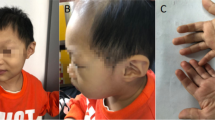Abstract
Mutations in the WT1 gene can lead to Denys-Drash syndrome or Frasier syndrome and can also cause isolated nephrotic syndrome (NS). Most patients with isolated NS caused by WT1 mutations present as 46, XX phenotypic females. There have been two cases with an onset age younger than 3 years with isolated NS caused by WT1 mutations presenting as 46, XY phenotypic males. We present a 46, XY phenotypic male patient with isolated NS and end-stage renal disease (ESRD) at the age of 6.3 years. He had normal male external genitalia with normal penis length and soft and normal volume of both testes. A mutation, 1051A>G (K351E), in exon 8 of WT1 was identified in the patient. After starting hemodialysis, manifestations of hypertension and renal failure improved, but he died at 6.8 years of age as a result of respiratory failure and heart failure. Our study supports the necessity of searching for mutations in WT1 in 46, XY phenotypic male patients with isolated NS and ESRD.


Similar content being viewed by others
References
Aucella F, Bisceglia L, De Bonis P, Gigante M, Caridi G, Barbano G, Mattioli G, Perfumo F, Gesualdo L, Ghiggeri GM (2006) WT1 mutations in nephrotic syndrome revisited. High prevalence in young girls, associations and renal phenotypes. Pediatr Nephrol 21:1393–1398
Benoit G, Machuca E, Antignac C (2010) Hereditary nephrotic syndrome: a systematic approach for genetic testing and a review of associated podocyte gene mutations. Pediatr Nephrol 25:1621–1632
Chernin G, Vega-Warner V, Schoeb DS, Heeringa SF, Ovunc B, Saisawat P, Cleper R, Ozaltin F, Hildebrandt F; Members of the GPN Study Group (2010) Genotype/phenotype correlation in nephrotic syndrome caused by WT1 mutations. Clin J Am Soc Nephrol 5:1655–1662
Cho HY, Lee JH, Choi HJ, Lee BH, Ha IS, Choi Y, Cheong HI (2008) WT1 and NPHS2 mutations in Korean children with steroid-resistant nephrotic syndrome. Pediatr Nephrol 23:63–70
Li J, Ding J, Zhao D, Yu Z, Fan Q, Chen Y, Zhang H, Zhong X, Huang J, Yao Y, Xiao H (2010) WT1 gene mutations in Chinese children with early onset nephrotic syndrome. Pediatr Res 68:155–158
Mucha B, Ozaltin F, Hinkes BG, Hasselbacher K, Ruf RG, Schultheiss M, Hangan D, Hoskins BE, Everding AS, Bogdanovic R, Seeman T, Hoppe B, Hildebrandt F; Members of the APN Study Group (2006) Mutations in the Wilms’ tumor 1 gene cause isolated steroid resistant nephrotic syndrome and occur in exons 8 and 9. Pediatr Res 59:325–331
Ruf RG, Schultheiss M, Lichtenberger A, Karle SM, Zalewski I, Mucha B, Everding AS, Neuhaus T, Patzer L, Plank C, Haas JP, Ozaltin F, Imm A, Fuchshuber A, Bakkaloglu A, Hildebrandt F; Members of the APN Study Group (2004) Prevalence of WT1 mutations in a large cohort of patients with steroid-resistant and steroid-sensitive nephrotic syndrome. Kidney Int 66:564–570
Takata A, Kikuchi H, Fukuzawa R, Ito S, Honda M, Hata J (2000) Constitutional WT1 mutations correlate with clinical features in children with progressive nephropathy. J Med Genet 37:698–701
Yu Z, Ding J, Huang J, Yao Y, Xiao H, Zhang J, Liu J, Yang J (2005) Mutations in NPHS2 in sporadic steroid-resistant nephrotic syndrome in Chinese children. Nephrol Dial Transplant 20:902–908
Acknowledgments
We thank Professor Jie Ding for her assistance with the grants. This project was supported by the Natural Science Foundation of Fujian Province of China (2006 J0119). The authors declare that they have no conflicts of interest.
Author information
Authors and Affiliations
Corresponding author
Rights and permissions
About this article
Cite this article
Yang, Y., Feng, D., Huang, J. et al. A child with isolated nephrotic syndrome and WT1 mutation presenting as a 46, XY phenotypic male. Eur J Pediatr 172, 127–129 (2013). https://doi.org/10.1007/s00431-012-1770-0
Received:
Accepted:
Published:
Issue Date:
DOI: https://doi.org/10.1007/s00431-012-1770-0




